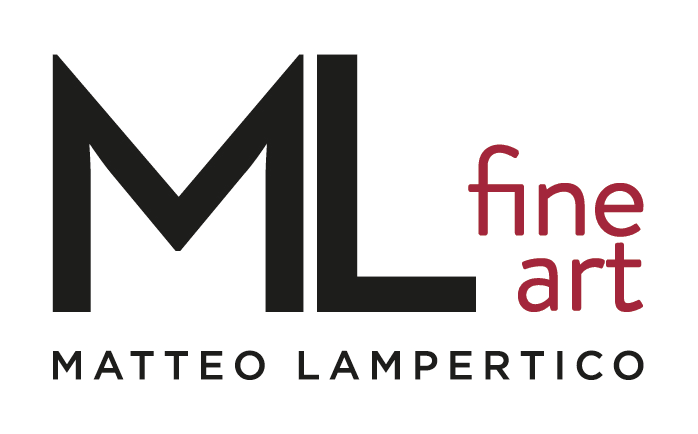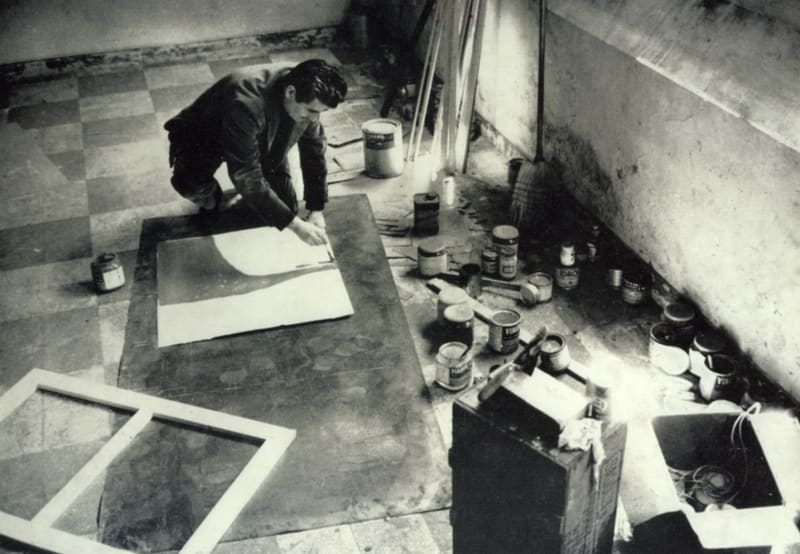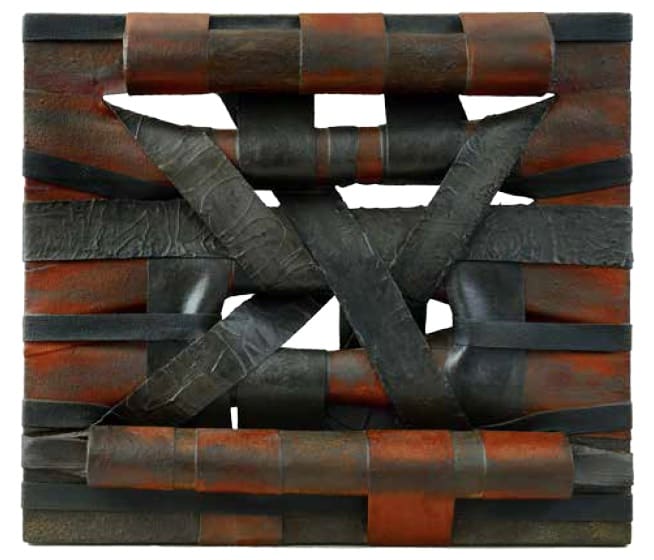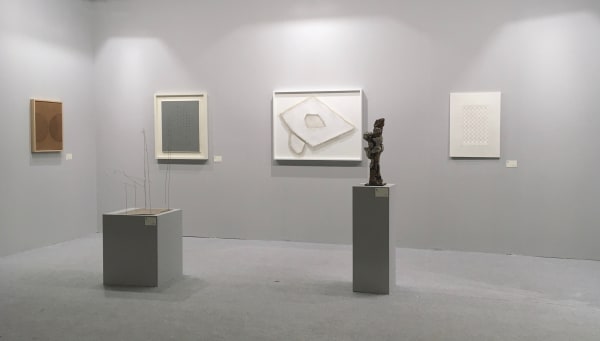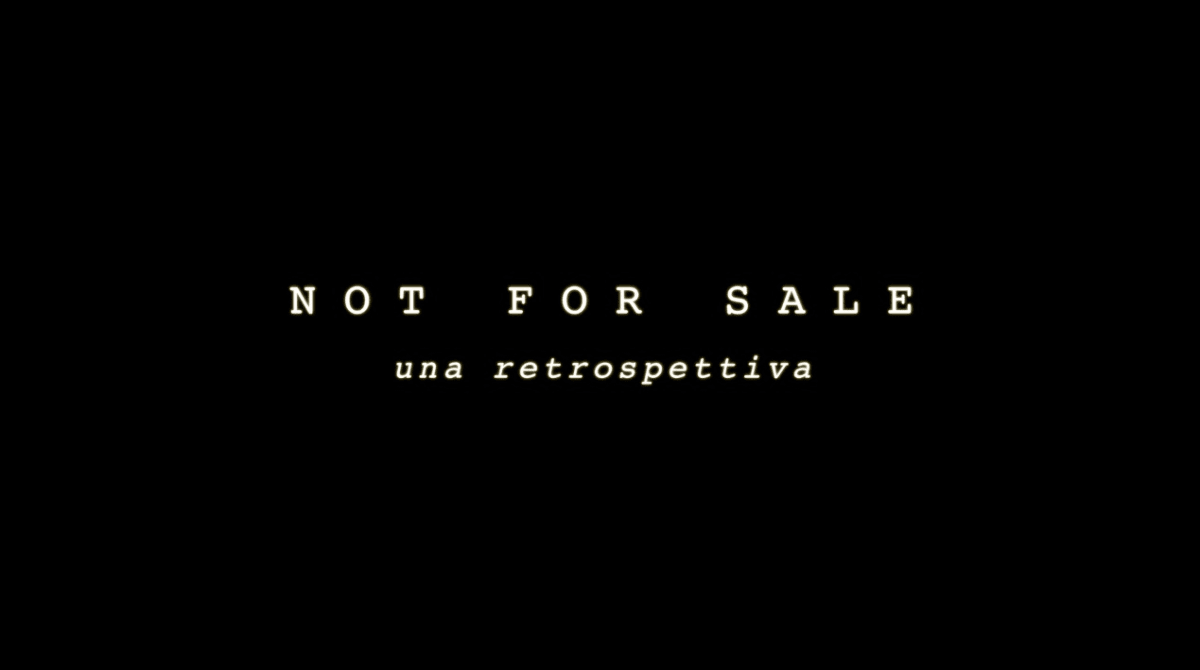Alberto Burri Italian, 1915-1995
Born in 1915, Alberto Burri was a doctor before the war, a combat medic in Libya during it, and finally a prisoner in Texas, where he started painting. He denied links between the gaping wounds of his works and his medical experience; incontestable, though, is the connection between his scarred, scorched compositions and the war-ravaged wasteland of the Italy to which he returned in 1946, a place of economic and psychological collapse. Yet his violent processes redeemed it as beautiful, each work “perfect as form and as space” as he wanted. Burnt transparent plastic glistens like pools of water in Plastica; cracked acrovinyl on cellotex creates the lovely wandering labyrinth Cretto G 3. For Arte Povera and, more widely, process artists, Burri’s metabolising of tar, sacking, charred wood, iron, plastic — examples of each series are included here — was foundational. Twenty-five years after his death, he remains, as Fabio Mauri called him, “king of the wretchedness that makes up the world”
Alberto Burri was born March 12, 1915, in Città di Castello, a small town in the Umbria region of Italy. In 1940 he received a degree in medicine from the Università degli Studi di Perugia. He served in the Ethiopian campaign and in World War II, first as a frontline soldier and then as a physician. Following his unit’s May 1943 capture in Tunisia, Burri was sent to a prisoner-of-war camp in Hereford, Texas. Disaffected by war and by his internment, he took up painting in an autodidactic, figurative style and never practiced medicine again.
In February 1946, Burri was repatriated to Italy and set up a studio in Rome. After his first solo exhibition, at the Galleria La Margherita in 1947, he visited Paris and was influenced by Joan Miró’s collages and Jean Dubuffet’s thickly painted works incorporating tar. Burri exhibited with the Rome Art Club, which familiarized him with Futurist arte polimaterica (“multimaterial” art). Experimenting with unorthodox pigments and resins, he produced his Catrami (tars) and Muffe(molds), as well as protruding, sculptural canvases that he called Gobbi(hunchbacks). By 1950 he was making assemblages out of burlap bags and household linens—Sacchi (sacks) and Bianchi (whites)—that garnered him international acclaim. His first solo exhibitions in the United States took place in 1953 at the Allan Frumkin Gallery, Chicago, and the Stable Gallery, New York; that same year his work appeared in Younger European Painters: A Selection (1953–54) at the Solomon R. Guggenheim Museum. The Carnegie Museum of Art in Pittsburgh organized his midcareer retrospective in 1957.
Burri developed a new material realism that stood apart from postwar gestural abstraction and its emotive and existentialist content. He blurred the boundaries between painting and relief sculpture and redefined the concept and the making of the monochrome. In the mid-1950s he turned to mass-produced industrial materials in prefabricated colors and developed a new technique of painting with combustion to make torched wood veneer works Legni (woods); welded reliefs of cold-rolled steel Ferri (irons); and compositions of melted and charred plastic Combustioni plastiche (plastic combustions).
Burri married the American dancer-choreographer Minsa Craig in 1955, and from 1963 until 1991 they wintered in Los Angeles, where the artist began a dialogue with Minimalism. His Cretti, monochromatic (black or white) fields of induced craquelure, date from the 1970s. The monumental Grande cretto (1985–89) that he built over the ruins of Gibellina, a Sicilian town destroyed by a 1968 earthquake, is one of the largest Land art works ever realized. As part of the foundation he established in 1978, Burri designed his own museum in Città di Castello’s Palazzo Albizzini, and it opened in 1981. In 1990 works from his last series, the Cellotex, painted on flayed fiberboard, went on permanent display in a nearby complex of former tobacco-drying sheds known as the Ex Seccatoi del Tabacco. The artist died February 15, 1995, in Nice.
-
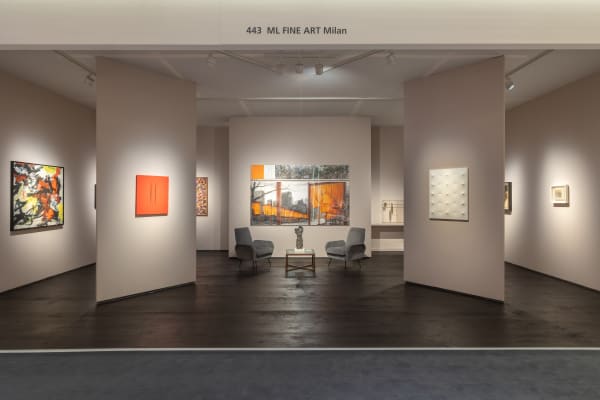
TEFAF Maastricht 2024
7 - 14 Mar 2024We are looking forward to seeing you at TEFAF Maastricht 2024! On this occasion our booth will showcase a selection of historically relevant paintings, sculptures...Read more -

Artgenève 2019
31 Jan - 3 Feb 2019Led by important and historic works by Théodore Géricault, Paul Gauguin, Lucian Freud and Piero Manzoni, M&L Fine Art's booth presented a tightly curated booth...Read more -
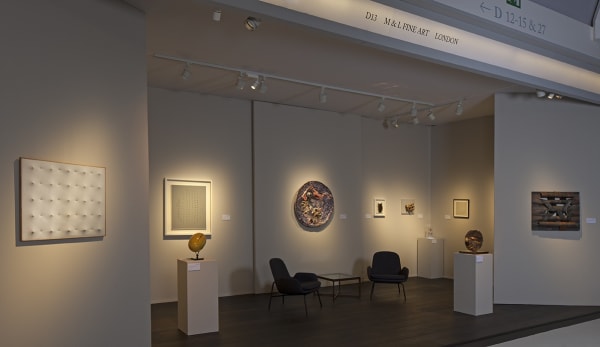
Masterpiece London 2017
29 Jun - 5 Jul 2017Read more -

Miart 2017
31 Mar - 2 Apr 2017Read more
